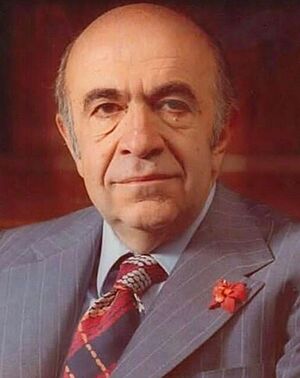Prime Minister of Iran facts for kids
Quick facts for kids Prime Minister of Iran |
|
|---|---|

Emblem of Iran
(1980–1989) |
|
| Member of | Cabinet of Iran Supreme National Security Council |
| Residence | Palace Abyaz Palace Prime Minister |
| Nominator | Parliament President (1980-1989) |
| Appointer | Shah (1906-1979) Parliament (1980-1989) |
| Precursor | Grand Vizier of Persia |
| Formation | 30 December 1906 |
| First holder | Mirza Ali Asghar Khan |
| Final holder | Mir-Hossein Mousavi |
| Abolished | 3 August 1989 |
| Succession | President of Iran (as head of government) |
The prime minister of Iran was an important political job in Iran. This role existed for most of the 20th century. It started in 1906 during the Qajar dynasty. The job continued through the Pahlavi dynasty and after the 1979 Iranian Revolution. The position was finally ended in 1989.
Contents
History of the Prime Minister's Role
The Qajar Era: Early Leaders
During the Qajar dynasty, prime ministers had different names. The main titles were ataabak or ataabak-e a'zam, meaning "grand ataabak". Sometimes they were called sadr-e a'zam, which means "premier". Later, the title became ra'is ol-vozaraa, or "head of ministers". The name nakhost vazir (prime minister) was not used often. People often called the prime minister by the special title hazrat-e ashraf. Reza Khan Sardar Sepah was the last prime minister under the Qajar dynasty in 1923.
To learn about earlier leaders before 1907, see List of grand viziers of Persia.
The Pahlavi Era: Modernizing Iran
In 1925, Reza Shah became the ruler of Iran. He appointed Mohammad Ali Foroughi as his first prime minister. Later, in 1941, Reza Shah's son, Mohammad Reza Pahlavi, became the new Shah. He also chose Mohammad-Ali Foroughi to be prime minister.
In 1951, Mohammad Mosaddegh became Prime Minister. He was a very popular leader. However, he was removed from power in 1953. Amir-Abbas Hoveyda served as Prime Minister for a long time, from 1965 to 1977. Shapour Bakhtiar was the last Prime Minister during the Pahlavi era.
The Islamic Republic: A New System
After the Iranian Revolution in 1979, Ayatollah Ruhollah Khomeini appointed Mehdi Bazargan as the first Prime Minister of the new government. This temporary government served until November 1979. The government resigned during the Iran hostage crisis. However, they said their decision to resign was made before the US embassy was taken over.
The prime minister's job was empty for a while. Then, Abolhassan Banisadr became president in January 1980. He chose Mohammad-Ali Rajai as his prime minister. This choice was mainly due to pressure from the Majlis, which is Iran's parliament. Rajai served until Banisadr was removed from office in June 1981. Rajai was then elected president in July 1981.
President Rajai chose Mohammad Javad Bahonar as his prime minister. Sadly, both Rajai and Bahonar were killed in an attack at the Prime Minister's office on August 30, 1981.
When Ali Khamenei became president in October 1981, he wanted to appoint Ali Akbar Velayati as prime minister. However, the parliament did not agree. They wanted Mir-Hossein Mousavi instead. The disagreement was settled when the Supreme Leader, Ayatollah Khomeini, advised the president to accept Mousavi.
Mousavi held the position until 1989. At that time, Iran's constitution was changed. The job of Prime Minister was ended. Its responsibilities were split between the president and a new role called first Vice President.
List of Prime Ministers
Related Topics
- List of grand viziers of Persia
- History of Iran
| Head of government of Iran | ||
|---|---|---|
| Preceded by Grand Vizier of Iran |
Prime Minister of Iran 1906–1989 |
Succeeded by President of Iran |


